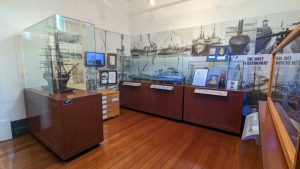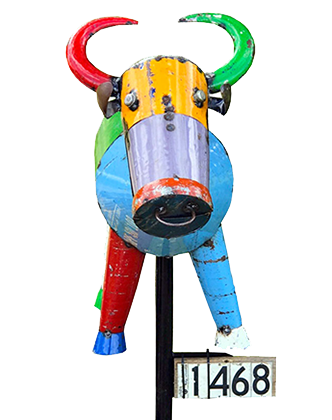Let’s have a look at some places close to Glencoe, and things to do in Devonport and around Sheffield, which are less known but well worth a visit.
Glencoe Guesthouse is ideally situated for trips to Cradle Mountain and a whole host of other famous Tassie locations, including Devonport, Sheffield and many others.
The Kentish Museum in Sheffield. The Museum features items from everyday life such as clothing, household appliances, wall phones and farm equipment from the late 1800s.
The first change-giving automatic petrol pump ever to be invented takes pride of place in the Kentish Museum because the inventor came from Sheffield.
The intriguing story of how this machine came on to the world stage is one of missed opportunity. The Goliath Portland Cement Company at Railton started its journey in the 1920s.
Throughout its history, the company has produced the highest quality cement available in the world. This cement has been used in both large and small building projects within Australia, including Sydney Harbour Bridge.
Historical machinery from the Goliath Portland Cement Company can be found at the Kentish Museum. Kentish Museum offers a genealogy service that enables visitors the opportunity to trace their family history.
The museum has access to state, national and international records and a collection of local marriage, birth, death and baptism records from churches. There is a small hourly fee for this service.
Over the years, Barb Wells has solved many family mysteries. In one case, the mystery lasted over 80 years with a family discovering an inter-family adoption. The family was overjoyed with the result.
People are surprised to find out information they were unaware of. Perhaps a convict they had not been told about or a brother or sister that may have died young.
Many hundreds of descendants from our early pioneers have come from all over the world to find pieces of their family puzzles.
Bass Straight Maritime Centre
 There is a rich maritime history associated with the area around Devonport. The Bass Strait Maritime Centre has several collections to view and there is also a cafe to get a cuppa.
There is a rich maritime history associated with the area around Devonport. The Bass Strait Maritime Centre has several collections to view and there is also a cafe to get a cuppa.
Separating Tasmania from mainland Australia, Bass Strait is notorious for its ‘boisterous weather.’ Shallow, and exposed to the fury of the southern trade winds, its waves are steep and the currents unpredictable.
Similar to the North-West Passage in the Northern Hemisphere, Bass Strait was of enormous interest to the British in the late 1700s looking for a quicker route to their colonies.
When it was finally proved to exist, it caused an international stir. The discovery also began a maritime carnage few places in the world have seen.
Over the 1800s, around 1500 ships came to grief making their way between the ‘eye of the needle’ (the gap between King Island and Cape Otway) in the west, or across the ‘edge of the shelf’ (the continental shelf where the Strait meets the Tasman Ocean) at the eastern end.
The story of Devonport is an important chapter in the story of Bass Strait. Since the 1850s, Devonport has been a major port providing connection between the island and mainland Australia and the Strait has always presented challenges to those steering a course through or across the waters.
Tasmania is an island because of the notorious stretch of water known as the Bass Strait. The story of Devonport is entwined with the story of the Bass Strait and at times our port city has played a central role in Tasmania’s maritime history.
The Bass Strait Maritime Centre Collection and exhibitions reflect that connection with the following themes:
Local history – The story of Torquay and Formby, two towns amalgamating to become Devonport in 1890; from the pioneers such as the Cocker, Fenton, Holyman and Henry families and their influence on the emergence of Devonport as the key port on the Northwest coast in the early 1900s to modern day Devonport.
Maritime History – Devonport’s apogee as a maritime centre was between 1880 and 1930, at the time when steamships were replacing sailing ships.
Devonport’s shipbuilders were building the largest steamships in the state. Pioneers such as the Wood, Holyman, Griffiths and Burgess families shaped the foundations of Devonport’s rich maritime heritage.
Bass Strait Transport – From sail to steam, from steam to the roll on/roll off ferries and the evolution of cargo handling to our current shipping container…the simple and ubiquitous invention that transformed ports and the way cargo is handled.
The shift from a mere journey across the Strait for the passenger to the age of elegant travel via ship and air travel was the result of vision and investment by the Holyman family – second generation shipbuilders and owners from Devonport.
Bass Strait Fishing – The Centre showcases the history of the newly refurbished vessel, the Julie Burgess, and its history as a cray-fishing ketch working Bass Strait from 1938 to the 1980s.
The fishing industry and its border tensions, early and current fishing practices and innovations contribute to the Bass Strait stories.
So, why not give us a call and make us your home away from home for your visit?



